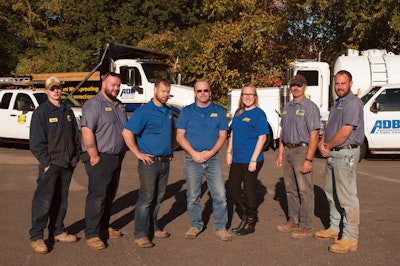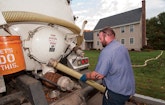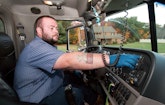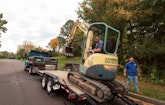
Interested in Industrial?
Get Industrial articles, news and videos right in your inbox! Sign up now.
Industrial + Get AlertsFor most businesses, answering phone calls from potential customers is simply a means to an end: booking a job. But at ADB Construction & Septic, phone calls are viewed as a marketing opportunity — a chance to probe callers for valuable information and promote other services offered by the well-diversified company.
“We used to get phone calls from customers who would ask for a specific service and that’s where it would end,” says Arthur Breault, owner of the company based in Manchester, Connecticut. “But now we try to do more than just sell a job. We try to get more information when they call and explain that we not only do drain cleaning, for instance, but also pump septic tanks and replace sewer pipes.
“It’s almost like we interview customers, which brings us more work,” he continues. “Before, we were losing sales that we didn’t even know were out there. Better yet, it doesn’t cost us anything.”
The approach makes sense. By calling, customers are already indicating they’re interested in hiring the company. As such, they’re probably more receptive to taking a few minutes to listen. “We’ve already passed some kind of initial test for determining which contractor they’ll use,” says Justin Breault, Arthur’s son, the company’s service manager. “So now we get a chance to educate them about other services they may not know we offer.”
Receptionists also obtain callers’ email addresses, which are then used in future marketing efforts. Moreover, calls also provide an opportunity to explain to price-sensitive customers that there’s more to consider than cost when hiring a septic tank pumper.
“We want to help them understand who we are as a company,” Arthur says. “They need to understand that we’re selling a product. … A lot of guys will just throw a hose into a tank and start pumping, and the homeowner thinks they’re getting properly serviced. But we tell (potential) customers that we perform a mini-inspection of their system — check things like the condition of the tank and baffles, the water level and what we find inside the tank.
“Along the way, we explain that cheap prices will probably cost them more down the road,” he adds. “Sure, there are times when we have to decline jobs (when customers want a better rate). But we don’t lower our prices. Many times, customers don’t realize that the other guy’s price is so low because he may not be pumping full time, for example, and has no overhead and no insurance.”
TEACHABLE MOMENTS
When Arthur founded ADB Construction in 2005, he wanted to develop a company with customer education as its centerpiece.
“The industry has a bad rap as it is and I wanted to change that,” says Arthur, 59. “I wanted to explain to customers what we’re doing and why we’re doing it. There’s a lot of (mystery) in this industry from customers’ standpoints and sometimes companies take advantage of that.”
Arthur started out doing septic system repairs, equipped at first with nothing more than some basic hand tools and a 1972 Buick Skylark. But he reinvested profits back into the business, buying more tools and equipment to increase efficiency. He also started installing sewer lines for homes being converted from septic service; at that point, he subbed out pumping work to a friend.
“Things were still a little slow for the first five years,” Arthur says. “But then business exploded. Our (gross) revenue has increased between 400 and 500 percent in the last five years.”
Arthur says the company’s educational approach played a large role in that growth. And it doesn’t end with the initial phone call; drivers take time on job sites to explain procedures to customers and build relationships. To allow time to do that, the company schedules fewer stops for its drivers than it otherwise could, Justin notes.
“If a driver has eight or nine pump-outs in a day, he’s jamming — there’s no time to be personal with customers,’’ Justin explains. “We like to see them take a couple of minutes to say hello, shake hands and explain what’s going on with their system.”
EXPANDING SERVICES
In 2011, the company added drain cleaning to its menu of services. It was a natural fit because, often enough, clogged lines are the cause of customers’ septic system problems. Drain cleaning also created opportunities to sell other services, Justin says.
“Drain cleaning is essentially a loss leader that leads to larger repairs — gets us in the door with customers,” he says. “In some situations, we might clean lines and find a system needs to be replaced, but the customer can’t afford $15,000 to $20,000 for a new system. The short-term solution is more frequent pumping. So we get the pumping business and when the customer has enough money, we get the installation business, too.”
In 2012, the company bought its first vacuum truck. Pumping out tanks was not only another logical extension of the company’s core services, it also boosted revenue that previously went to pumping subcontractors. “We started tracking the number of times we were hiring someone else to pump tanks,” Justin explains. “We found we were giving a lot of money to someone else.” Moreover, tank pump-outs often lead to drain cleaning work in order to solve customers’ problems, he adds.
In 2016, ADB invested in a Nu Flow pipe lining system, adding yet another complementary service to its core offerings. After noticing the growing need for replacing aging water and sewer infrastructure, the Breaults started looking at pipe lining systems at the WWETT Show. In addition, trenchless pipe lining is an attractive solution for customers who want to avoid tearing up driveways, sidewalks, patios and the like in order to replace sewer lines, Justin says.
Diversification not only allows the company to better serve customers, but also stabilizes the business. If one segment hits a cyclical lull — think tank pump-outs in winter, for instance — other segments keep contributing to cash flow. Employees stay busy, averting seasonal layoffs.
“When the economy got bad (in 2008 and 2009), companies with all their eggs in one basket got hurt,” Arthur says. “We flourished on one side even if another dried up. People might put off septic pumping for a year. But if their toilet isn’t working because a sewer line goes bad, they have no choice but to get it fixed.”
MORE EQUIPMENT
As services grow, so does the company’s fleet of equipment. On the septic end, the company relies on two trucks, built on 2013 Peterbilt 388 and 2001 Mack truck chassis. The Peterbilt was outfitted by Crown Tank with a 4,600-gallon steel tank and a Fruitland Mfg. vacuum pump. The Mack was built out by LMT Inc. with a 4,000-gallon steel tank and a Wittig pump (Gardner Denver).
For drain cleaning, technicians use a RIDGID K-330 cart-mounted jetter (3,000 psi at 5.5 gpm), a Spartan 300 drum machine, a JM 1000 mini-jet toolbox jetter from General Pipe Cleaners, two RIDGID K-400 drum machines and three RIDGID SeeSnake pipeline inspection camera systems.
To support excavations for sewer line repairs and replacements, the company owns two Takeuchi excavators, one Takeuchi skid-steer, a Yanmar mini-excavator, a Big Tex equipment trailer, a 2016 Peterbilt with 16-cubic-foot Bibeau dump body, and a 2005 International 4300 with a Crysteel dump body. The company also owns a Chevy pickup equipped with a Knapheide utility body, a GMC cut-away van with a Stahl (a Scott Fetzer company) utility body, and a 2010 Ford van. To carry the pipe lining system, the company bought a 16-foot Sure-Trac enclosed trailer.
GATHERING INTEL
When the Breaults need to educate themselves, they attend the WWETT Show. Knowledge gleaned at the trade shows has led to valuable revenue-generating and efficiency-enhancing investments, like the Nu Flow pipe lining system.
“We get to meet and talk to other people — it’s a great place to network and share tricks of the trade, Arthur says. “When you talk to people who don’t operate in your market, they’re not afraid to share information.”
WWETT attendance led the Breaults to invest in RazorSync field-management software to improve productivity. For example, when a job is booked, essential customer information — phone number, email address and so forth — is added to the RazorSync system. “Sometimes our techs don’t even come to the office in the morning because they can call up their schedule on a smartphone,” Art says.
The system also tracks how much time it takes technicians to do jobs and enables them to input critical information, such as the location of septic tanks and the size of the tank, on reports that are scanned into the system. “Technicians can call up customers’ files on their cellphones and see what we did last time and who did the work,” Art explains. “The files might contain information as simple as a beware-of-dog warning or note that there’s no clean-out access in the basement.”
BRAND RECOGNITION
To establish a more prominent business profile, the Breaults are working with a marketing firm to ensure the company’s brand is consistently represented on a variety of platforms, from vinyl wraps on trucks and internet advertising to technicians’ uniforms and business cards, invoices and yard signs. A key component is a new company logo.
“We want people to think of us when they think of waste and sewers,” Justin explains. “If you’re not pushing forward as a business and striving to be better — be a leader in your industry — then you’re stagnant, and stagnant businesses don’t last very long. We really want to keep growing our business, and creating a fresh brand seemed to be the most logical next step.”
While growth is important, the Breaults believe that slow and steady is better than exponential increases. “Two years ago, we grew too much, too fast,” Arthur says. “But we’ve stabilized that a bit and now we’re concentrating more on developing employees.”
Currently, septic-related business generates about 60 percent of the company’s revenue, while drain cleaning kicks in another 30 percent and pipe lining contributes the balance. Arthur says further growth could come from buying additional equipment, such as a trailer-mounted water jetter or a portable grease-trap pumping unit. He also expects pipe lining to become a bigger part of the company’s business in the years ahead.
“Down the road, we’re even thinking about getting into portable restrooms,” he adds. “We think the future looks really, really good.”
Kids, trucks and charity
Last year marked the first time ADB Construction & Septic participated in the annual Wishes On Wheels event, which raises money for the Make-A-Wish Foundation. And Justin Breault, the service manager of the Manchester, Connecticut-based business, vows it won’t be the last.
In 2016, the event — held in nearby East Hartford — raised more than $100,000 for children with life-threatening conditions. Breault was one of more than 530 drivers who paid $25 each to participate in the fundraising convoy, in which people from all manner of businesses drive their rigs on a roughly 22-mile loop, mostly on I-384.
“It’s a massive event,” says Breault, the son of company owner Arthur Breault. “By the time the first trucks are returning to the starting point, other trucks are still waiting to leave. The sheer magnitude of all those trucks rolling down the highway is mighty impressive. People stand on the overpasses with signs and wave at the trucks.”
The trek starts and ends at Pratt & Whitney Stadium at Rentschler Field, the football and soccer home of the University of Connecticut Huskies. A variety of events are held after the convoy, including contests for best-looking truck, most unusual truck, and the truck that traveled the farthest to participate.
Breault drove the company’s Peterbilt dump truck while route driver Chris Barnard piloted a 2013 Peterbilt vacuum truck. “You see all kinds of trucks, including wreckers, box trucks, semi tractors, UPS and FedEx delivery trucks, dump trucks, hook-lift trucks and crane trucks,” Breault says.
In many cases, a sick child rides shotgun with a truck driver. The reaction from the children is priceless, Breault says. And the emotions run even higher during a ceremony held later inside the stadium, where participating children get introduced and announce their individual wishes. “There’s not a dry eye in the crowd,” he says.
The company also participates in many other local charitable events. “Charity and giving back is really important,” says Arthur Breault. “It’s only right that we give back to the towns and communities that have done right by us.”
As for the Wishes On Wheels event, Breault says it’s penciled in on the calendar for next year. “We’re going to try to make this a routine event every year,” he notes. “It’s really worth the time.”









